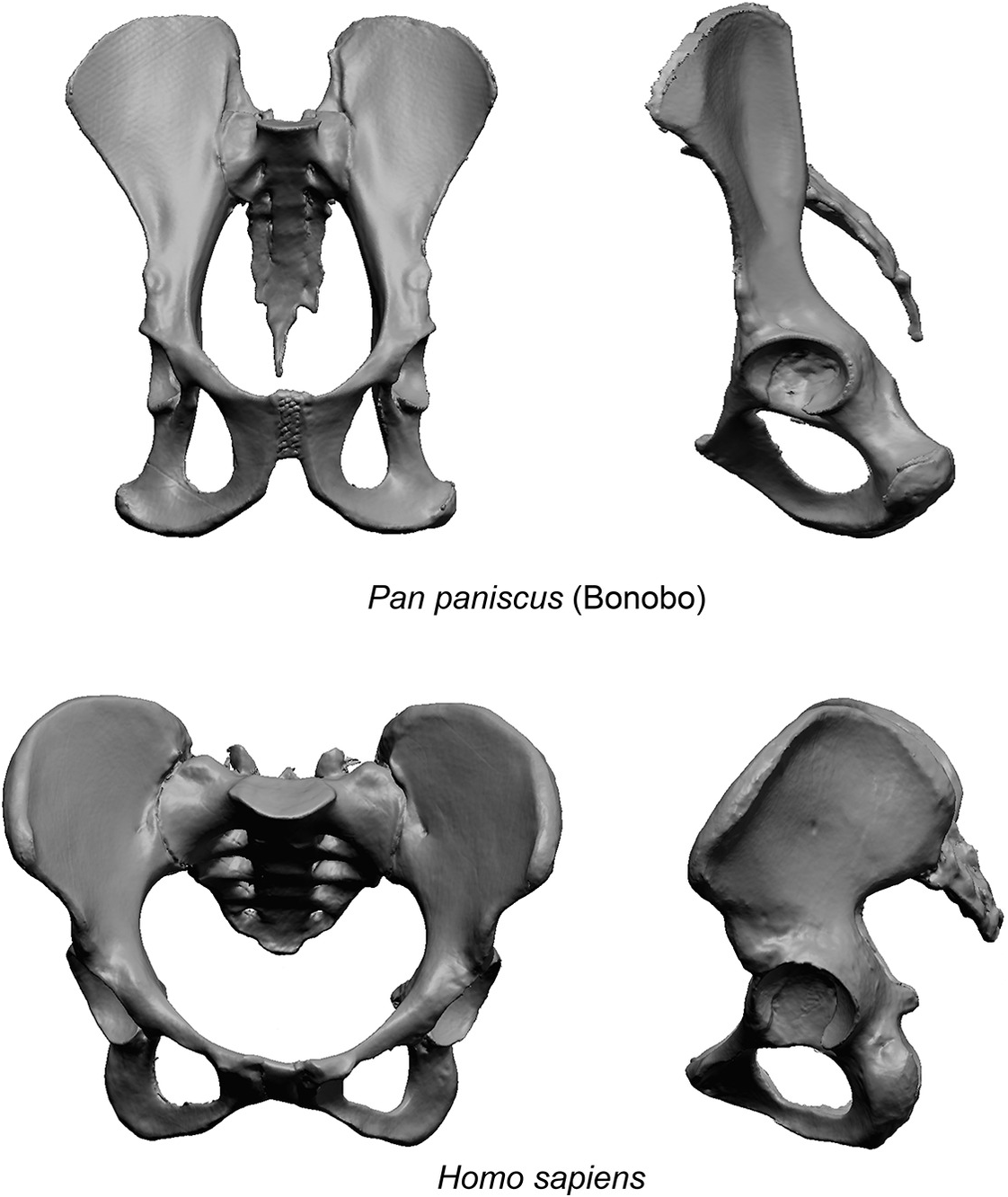Human pelvis evolution represents a pivotal chapter in the story of our species, marking the transition to upright locomotion and the complex mechanics of bipedal walking. Over millions of years, the anatomy of the pelvis has undergone remarkable changes, allowing our ancestors to adapt to a life spent primarily on two legs. Unlike other primates, whose pelvises are tall and narrow, the human pelvis is short and broad, optimized for balance and movement. Recent studies reveal that specific genetic changes in the pelvis play a crucial role in these evolutionary transformations, highlighting how our anatomical structure is intricately linked to our ability to navigate various terrains. As we delve deeper into the evolution of pelvis anatomy, we uncover the fascinating interplay between genetic adaptations and the demands of a changing environment, setting the stage for the emergence of modern humans.
The evolution of the human pelvis is not merely a tale of anatomical changes but a fascinating exploration of our ancestry and adaptation. As our ancestors shifted from tree-dwelling primates to ground-dwelling bipeds, significant alterations in pelvic structure occurred, enabling them to walk on two legs efficiently. This transition involved reconfiguration of pelvic bones and modifications in growth processes, underscoring the role of genetic factors in shaping our skeletal framework. Within the broader context of primate evolution, this unique adaptation not only facilitated upright movement but also addressed the challenge of birthing larger brain babies, known as the obstetrical dilemma. Understanding these changes sheds light on how humans became the conscious, upright creatures we are today, navigating the world with both grace and complexity.
The Evolution of the Human Pelvis: A Historical Perspective
The evolution of the human pelvis is a significant milestone in our species’ journey towards upright locomotion. Over millions of years, our ancestors adapted from the longer and narrower pelvis of quadrupedal primates, such as chimpanzees and gorillas, to the broad, basin-shaped structure we see in modern humans today. This transformation is not merely a change in appearance but a fundamental evolutionary advance that supports bipedal walking, enabling the anatomical adaptations necessary for balance, weight distribution, and the efficient locomotion inherent to our species.
The historical perspective of pelvic evolution indicates that these changes began approximately 5 to 8 million years ago, coinciding with the divergence of our ancestors from African apes. During this period, humans underwent significant genetic modifications that shaped not only the pelvis anatomy but also influenced locomotion patterns. As brain size increased, anatomical adaptations in the pelvis became crucial in addressing the obstetrical dilemma, where wider hips facilitate childbirth for larger-brained infants while maintaining bipedal efficiency.
Genetic Changes Driving Pelvic Evolution in Humans
Recent studies have uncovered critical genetic changes that underpin the evolution of the human pelvis. Researchers have identified specific genes such as SOX9 and PTH1R that play an essential role in the transition from a quadrupedal limb structure to a bipedal pelvis. These genetic adaptations are believed to have triggered a 90-degree shift in the growth plate of the ilium, making the hipbones broader and suitable for bipedal locomotion. This genetic foundation illustrates the remarkable connection between genetic evolution, physical anatomy, and functional biomechanics.
Moreover, the re-alignment of growth plates and the unique ossification process are considered pivotal evolutionary developments that distinguish humans from other primates. While the ossification pattern in many mammals begins in the middle of the bone, the human pelvis diverged with an anteriorly delayed ossification that supports wider pelvic structures. The implications of these genetic alterations are particularly relevant as they elucidate the complexities of primate evolution and highlight the unique pathway humans took in developing bipedal mobility.
The Role of Pelvis Anatomy in Bipedal Walking
Pelvis anatomy plays a critical role in bipedal walking, serving as a structural foundation that supports the entire body’s weight when humans stand and move. The bowl-shaped pelvis allows for an efficient center of gravity that maintains balance and stability. This unique biomechanical engineering is what enables humans to shift their weight seamlessly from one leg to the other during walking, running, and other forms of locomotion. The flaring hipbones support muscle attachments that are essential for movement, which distinguishes human locomotion from that of other primates who rely more on climbing abilities.
In the context of primate evolution, the modifications in pelvis anatomy that distinguish humans from their cousins reflect broader adaptations for terrestrial living. This evolution not only supports upright locomotion but also facilitates other activities such as foraging and running long distances. By transforming pelvic anatomy, humans adapted to new environmental pressures, further promoting survival and contribution to eventual development as a species that heavily relies on bipedal movement.
Human Pelvis Evolution: Implications for Primate Evolution
The evolution of the human pelvis has broad implications for understanding primate evolution. It illustrates the intricate relationships between genetic adaptations and functional changes in anatomy that can occur over millions of years. By studying the modifications in pelvis design, researchers gain insights into the adaptive strategies primates implemented in response to environmental challenges, which contributed to their eventual success in diverse habitats. Furthermore, the anatomical evolution of the pelvis can provide a more comprehensive view of how other human traits developed.
Additionally, this evolution prompts scientists to reconsider models of physical and ecological change within the primate lineage. It challenges previously held notions that simply equated pelvis shape with locomotion efficiency without accounting for the underlying genetic changes that drive these anatomical shifts. The distinctive traits of the human pelvis have become a pivotal point in examining how environmental selection pressures have shaped not only our physiology but also our behavior as bipedal primates through evolutionary history.
The Obstetrical Dilemma and Pelvic Evolution
The obstetrical dilemma presents a fascinating intersection between pelvic anatomy and the evolution of human reproduction. As humans evolved, two competing demands arose: the necessity for a wider pelvis to accommodate increasingly larger-brained infants and the need for a narrower pelvis that facilitates efficient bipedal locomotion. This trade-off plays a crucial role in shaping pelvic anatomy and highlights the remarkable evolutionary balancing act that our ancestors faced. The modifications observed in the pelvic structure must therefore be understood within this context of competing evolutionary pressures.
As brain size increased, the adaptations necessary for human childbirth became more pronounced. The pelvic changes that occurred over millions of years not only allowed for bipedal walking but also facilitated successful childbirth. This dual functional capability underscores the complexity of evolutionary adaptations in the pelvis. The delay in ossification and alterations in growth patterns signal a remarkable evolutionary response to the demands of both locomotion and reproduction, illustrating how intertwined these aspects of human evolution truly are.
Frequently Asked Questions
What are the key genetic changes related to human pelvis evolution?
Recent studies have identified two significant genetic changes that contributed to human pelvis evolution. These include a 90-degree shift in the pelvic growth plate, which resulted in the ilium becoming wider instead of tall, and a change in the ossification timeline of the pelvis bones. These shifts allowed for a pelvis shape that supports bipedal walking, marking a departure from other primates.
How did the evolution of the human pelvis support upright locomotion?
The evolution of the human pelvis has been crucial for upright locomotion. Unlike other primates, the human pelvis is bowl-shaped due to the rotation of the ilia, which facilitates balance and weight transfer during bipedal walking. This unique pelvis anatomy allows for effective movement on two legs, setting humans apart in primate evolution.
What role does pelvis anatomy play in bipedal walking?
Pelvis anatomy is pivotal for bipedal walking as it provides structural support and balance. The flaring hipbones create attachment points for muscles that stabilize the body while walking and running. This adaptation in pelvis shape, observed throughout human evolution, enables the efficient locomotion associated with being a bipeds.
How did primate evolution impact the development of the human pelvis?
Primate evolution significantly impacted the development of the human pelvis by introducing genetic and structural changes. As humans branched off from common ancestors with African apes, adaptations such as a shorter, wider pelvis emerged, facilitating upright locomotion and the ability to carry larger brains. This transition reflects a critical shift from adaptations seen in other primates.
What is the obstetrical dilemma in relation to human pelvis evolution?
The obstetrical dilemma refers to the evolutionary trade-off between having a narrow pelvis, which is advantageous for efficient bipedal walking, and a wider pelvis, which facilitates childbirth for larger-brained infants. This dilemma highlights the selective pressures that influenced the shape and structure of the human pelvis throughout evolution.
When did the significant changes in pelvis evolution begin?
Significant changes in pelvis evolution are estimated to have begun between 5 million and 8 million years ago, coinciding with the divergence of humans from African apes. These changes reshaped the pelvis’s structure, aligning it with the needs of bipedal locomotion and the demands of larger brain sizes.
How does human pelvis evolution differ from other primates?
Human pelvis evolution is distinct from other primates in both genetics and anatomy. The human pelvis underwent unique shifts, like the rotation and broadening of the ilium, which are not observed in primates such as chimpanzees. This evolutionary path aimed to enhance bipedal walking, marking a key difference in pelvis structure between humans and other primates.
What evidence supports the evolutionary changes in the human pelvis?
Evidence supporting evolutionary changes in the human pelvis comes from the analysis of embryonic tissues across various primate species, fossil records, and genetic studies. The discovery of specific genes controlling growth plate orientations and ossification processes illustrates how these adaptations occurred, fundamentally reshaping the human pelvis throughout evolution.
| Key Points |
|---|
| The pelvis is crucial for upright locomotion and underwent significant changes during human evolution. |
| Two key genetic and developmental shifts were identified that transformed the pelvis from that of quadrupedal primates to bipedal humans. |
| The upper hipbones in humans are wider and bowl-shaped compared to taller, narrower hipbones in apes. |
| Research involved analyzing embryonic tissues from multiple primate species to understand pelvis development. |
| Major changes involved a 90-degree shift in growth plates and alterations in the ossification timeline. |
| The transformation is believed to have started 5-8 million years ago when ancestors branched from African apes. |
| The pelvis underwent continued evolution due to increasing brain size and the ‘obstetrical dilemma’. |
| Fossil records, such as Ardipithecus and Lucy, provide evidence of the evolutionary changes in the pelvis. |
| This research suggests a re-evaluation of how we understand the growth of hominid pelvis compared to other primates. |
Summary
Human pelvis evolution has played a pivotal role in our ability to walk upright, which is central to our development as a species. The recent study highlights essential genetic and developmental changes that have reshaped the pelvis over millions of years, distinguishing humans from their primate relatives. Understanding these transformations not only sheds light on our evolutionary past but also emphasizes the unique adaptations that have facilitated bipedal locomotion in humans.

